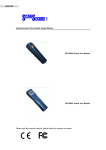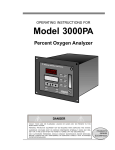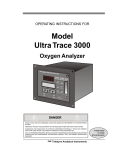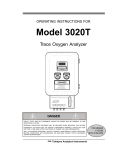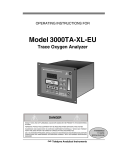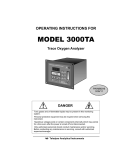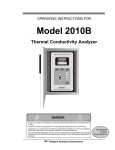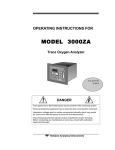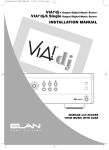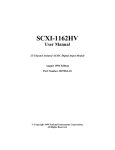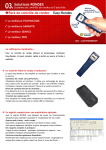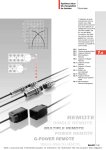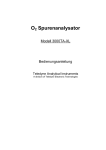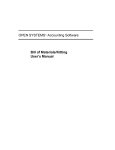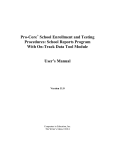Download Teledyne 3010MB Oxygen Equipment User Manual
Transcript
Percent Paramagnetic Oxygen Analyzer
OPERATING INSTRUCTIONS
Model 3010MB
Percent Paramagnetic
Oxygen Analyzer
Bulkhead Mount Control Unit, PN D-71385
Bulkhead Mount Analysis Unit, PN D-71394
DANGER
HIGHLY TOXIC AND OR FLAMMABLE LIQUIDS OR GASES MAY BE PRESENT IN THIS MONITORING
SYSTEM.
PERSONAL PROTECTIVE EQUIPMENT MAY BE REQUIRED WHEN SERVICING THIS SYSTEM.
HAZARDOUS VOLTAGES EXIST ON CERTAIN COMPONENTS INTERNALLY WHICH MAY PERSIST
FOR A TIME EVEN AFTER THE POWER IS TURNED OFF AND DISCONNECTED.
ONLY AUTHORIZED PERSONNEL SHOULD CONDUCT MAINTENANCE AND/OR SERVICING. BEFORE
CONDUCTING ANY MAINTENANCE OR SERVICING CONSULT WITH AUTHORIZED SUPERVISOR/
MANAGER.
Teledyne Analytical Instruments
P/N xxxxxx
12/21/99
ECO: #99-0000
i
Model 3010MB
Copyright © 1999 Teledyne Analytical Instruments
All Rights Reserved. No part of this manual may be reproduced, transmitted,
transcribed, stored in a retrieval system, or translated into any other language or computer
language in whole or in part, in any form or by any means, whether it be electronic,
mechanical, magnetic, optical, manual, or otherwise, without the prior written consent of
Teledyne Analytical Instruments, 16830 Chestnut Street, City of Industry, CA 917491580.
Warranty
This equipment is sold subject to the mutual agreement that it is warranted by us
free from defects of material and of construction, and that our liability shall be limited to
replacing or repairing at our factory (without charge, except for transportation), or at
customer plant at our option, any material or construction in which defects become
apparent within one year from the date of shipment, except in cases where quotations or
acknowledgements provide for a shorter period. Components manufactured by others bear
the warranty of their manufacturer. This warranty does not cover defects caused by wear,
accident, misuse, neglect or repairs other than those performed by Teledyne or an authorized service center. We assume no liability for direct or indirect damages of any kind and
the purchaser by the acceptance of the equipment will assume all liability for any damage
which may result from its use or misuse.
We reserve the right to employ any suitable material in the manufacture of our
apparatus, and to make any alterations in the dimensions, shape or weight of any parts, in
so far as such alterations do not adversely affect our warranty.
Important Notice
This instrument provides measurement readings to its user, and serves as a tool by
which valuable data can be gathered. The information provided by the instrument may
assist the user in eliminating potential hazards caused by his process; however, it is
essential that all personnel involved in the use of the instrument or its interface, with the
process being measured, be properly trained in the process itself, as well as all instrumentation related to it.
The safety of personnel is ultimately the responsibility of those who control process
conditions. While this instrument may be able to provide early warning of imminent
danger, it has no control over process conditions, and it can be misused. In particular, any
alarm or control systems installed must be tested and understood, both as to how they
operate and as to how they can be defeated. Any safeguards required such as locks, labels,
or redundancy, must be provided by the user or specifically requested of Teledyne at the
time the order is placed.
Therefore, the purchaser must be aware of the hazardous process conditions. The
purchaser is responsible for the training of personnel, for providing hazard warning
methods and instrumentation per the appropriate standards, and for ensuring that hazard
warning devices and instrumentation are maintained and operated properly.
Analytical Instruments, the manufacturer of this instrument, cannot accept
responsibility for conditions beyond its knowledge and control. No statement expressed
or implied by this document or any information disseminated by the manufacturer or its
agents, is to be construed as a warranty of adequate safety control under the user’s process
conditions.
ii
Teledyne Analytical Instruments
Percent Paramagnetic Oxygen Analyzer
Table of Contents
Specific Model Information ................................ iv
Preface................................................................ v
Part I: Control Unit, Model MB .............. Part I: 1-1
Part II: Analysis Unit, Model M ............ Part II: 1-1
Appendix ......................................................... A-1
Teledyne Analytical Instruments
iii
Model 3010MB
Specific Model Information
The instrument for which this manual was supplied may incorporate
one or more options not supplied in the standard instrument. Commonly
available options are listed below, with check boxes. Any that are incorporated in the instrument for which this manual was supplied are indicated by a
check mark in the box.
Instrument Serial Number: __________________________
.
iv
Teledyne Analytical Instruments
Percent Paramagnetic Oxygen Analyzer
Preface
Overview
The Analytical Instruments Model 3010MB Percent Paramagnetic
Oxygen Analyzer is a versatile microprocessor-based instrument for detecting parts-per-million (ppm) levels of oxygen in a variety of background
gases. It is a “split architecture” instrument. This means that a general purpose Control Unit, designed for nonhazardous areas only, remotely controls
a specially designed Analysis Unit, or remote probe.
Part I of this manual covers the Model 3010MB General Purpose
NEMA 4 Bulkhead mount Control Unit only. This Control Unit is for
outdoor/indoor use in a nonhazardous environment. The Analysis Units (or
Remote Probes) it controls, can be designed for a variety of hazardous
environments. Part II of this manual covers the 3010M Analysis Unit.
Typical Applications
A few typical applications of the Model 3010MB are:
• Monitoring inert gas blanketing
• Air separation and liquefaction
• Chemical reaction monitoring
• Semiconductor manufacturing
• Petrochemical process control
• Quality assurance
• Gas analysis certification.
Teledyne Analytical Instruments
v
Model 3010MB
Main Features of the Analyzer
The Model 3010MB Percent Oxygen Analyzer is sophisticated yet
simple to use. The main features of the analyzer include:
• A 2-line alphanumeric display screen, driven by microprocessor
electronics, that continuously prompts and informs the operator.
• High resolution, accurate readings of oxygen content from low %
levels through 100%. Large, bright, meter readout.
• Stainless steel sample system.
• Versatile analysis over a wide range of applications.
• Microprocessor based electronics: 8-bit CMOS microprocessor
with 32 kB RAM and 128 kB ROM.
• Three user definable output ranges (from 0-5 % through 0-100
%) allow best match to users process and equipment.
• Auto Ranging allows analyzer to automatically select the proper
preset range for a given measurement. Manual override allows
the user to lock onto a specific range of interest.
• Two adjustable concentration alarms and a system failure alarm.
• Extensive self-diagnostic testing, at startup and on demand, with
continuous power-supply monitoring.
• RS-232 serial digital port for use with a computer or other digital
communication device.
• Analog outputs for concentration and range identification.
(0-1 VDC standard, and isolated 4–20 mADC)
vi
Teledyne Analytical Instruments
Part I: Control Unit
OPERATING INSTRUCTIONS
Model 3010MB
Oxygen Analyzer
Part I: Control Unit
NEMA 4 Bulkhead Mount
Part Numbers: D-71385
Teledyne Analytical Instruments
Part I: i
Model 3010MB Percent Paramagnetic Oxygen Analyzer
Table of Contents
1 Introduction
1.1
1.2
1.3
1.4
Overview ........................................................................ 1-1
Control Unit Inner Control Panel .................................... 1-1
Recognizing Difference Between LCD & VFD ............... 1-3
Control Unit Interface Panel ........................................... 1-4
2 Operational Theory
2.1 Introduction .................................................................... 2-1
2.2 Electronics and Signal Processing ................................ 2-1
3 Installation
3.1
3.2
3.3
3.4
Unpacking the Control Unit ............................................ 3-1
Mounting the Control Unit .............................................. 3-1
Electrical Connections ................................................... 3-3
Testing the System ......................................................... 3-12
4 Operation
4.1 Introduction .................................................................... 4-1
4.2 Using the Data Entry and Function Buttons ................... 4-2
4.3 The System Function ..................................................... 4-3
4.3.1 Tracking the O2 Readings during Calibration ......... 4-4
4.3.2 Setting up an Auto-Cal ........................................... 4-5
4.3.3 Password Protection .............................................. 4-5
4.3.3.1 Entering the Password ................................... 4-6
4.3.3.2 Installing or Changing the Password ............. 4-7
4.3.4 Logout .................................................................... 4-8
4.3.5 System Self-Diagnostic Test .................................. 4-9
4.3.6 Version Screen ...................................................... 4-10
4.3.7 Showing Negative Oxygen Readings .................... 4-10
4.4 The Zero and Span Functions ....................................... 4-10
4.4.1 Zero Cal ................................................................. 4-11
ii: Part I
Teledyne Analytical Instruments
Part I: Control Unit
4.4.1.1 Auto Mode Zeroing ........................................ 4-11
4.4.1.2 Manual Mode Zeroing .................................... 4-12
4.4.1.3 Cell Failure .................................................... 4-13
4.4.2 Span Cal ................................................................ 4-14
4.4.2.1 Auto Mode Spanning ..................................... 4-14
4.4.2.2 Manual Mode Spanning ................................. 4-16
4.4.3 Span Failure .......................................................... 4-16
4.5 The Alarms Function ...................................................... 4-15
4.6 The Range Function ...................................................... 4-18
4.6.1 Setting the Analog Output Ranges......................... 4-19
4.6.2 Fixed Range Analysis............................................ 4-20
4.7 The Analyze Function .................................................... 4-20
4.8 Signal Output ................................................................. 4-21
5 Maintenance
5.1 Fuse Replacement......................................................... 5-1
5.2 System Self Diagnostic Test ........................................... 5-2
5.3 Major Internal Components ............................................ 5-3
A Appendix
Model 3010MB Specifications ............................................... A-1
Teledyne Analytical Instruments
Part I: iii
Model 3010MB Percent Paramagnetic Oxygen Analyzer
iv: Part I
Teledyne Analytical Instruments
Percent Paramagnetic Oxygen Analyzer
Part I: Control Unit
Introduction
1.1
Overview
The Analytical Instruments Model 3010MB Analyzer Control Unit,
together with a 3010M Analysis Unit, is a versatile microprocessor-based
instrument for detecting percent amounts of oxygen in a variety of gases.
Part I, this part, of this manual covers the Model 3010MB series General Purpose NEMA 4 Bulkhead mount Control Units. (The Analysis Unit is
covered in Part II of this manual.) The Control Unit and Analysis Unit is for
indoor/outdoor use in a nonhazardous environment only.
1.2
Control Unit Inner Control Panel
The standard 3010MB Control Unit is housed in a rugged NEMA 4
metal case with all remote controls and displays accessible from the inner
control panel. See Figure 1-1. The inner control panel has a digital meter, an
alphanumeric display, and thirteen buttons for operating the analyzer.
Teledyne Analytical Instruments
Part I: 1-1
1 Introduction
Model 3010MB
Outer Door
(Open)
Teledyne Analytical Instrument
Viewing
Window
0.0
AL-1
%
Anlz
Outer Door
Latch
3010MB Series
Paramagnetic Oxygen Analyze
Figure 1-1: Front of Unmounted Control Unit
Function Keys: Six touch-sensitive membrane switches are used to
change the specific function performed by the analyzer:
•
Analyze
Perform analysis for oxygen content of a sample gas.
•
System
Perform system-related tasks (described in detail in
chapter 4, Operation.).
•
Span
Span calibrate the analyzer.
•
Zero
Zero calibrate the analyzer.
•
Alarms
Set the alarm setpoints and attributes.
•
Range
Set up the 3 user definable ranges for the instrument.
1-2: Part I
Teledyne Analytical Instruments
Percent Paramagnetic Oxygen Analyzer
Part I: Control Unit
Data Entry Keys: Six touch-sensitive membrane switches are used to
input data to the instrument via the alphanumeric VFD display:
•
Left & Right Arrows
Select between functions currently
displayed on the VFD screen.
•
Up & Down Arrows
Increment or decrement values of
functions currently displayed.
•
Enter
•
Escape Moves VFD display back to the previous screen in a
series. If none remains, returns to the Analyze screen.
Moves VFD display on to the next screen in a series. If
none remains, returns to the Analyze screen.
Digital Meter Display: The meter display is a LED device that
produces large, bright, 7-segment numbers that are legible in any lighting. It
is accurate across all analysis ranges. The –MB model produce continuous
readout from 0-1% through 0-100%.
Alphanumeric Interface Screen: The backlit VFD screen is an easyto-use interface between operator and analyzer. It displays values, options,
and messages that give the operator immediate feedback.
I/O Power Button: The red I/O button switches the instrument power
between I (ON) and O (a Keep-Alive state). In the O state, the instrument’s
circuitry is operating, but there are no displays or outputs.
CAUTION: The power must be disconnected to fully
disconnect power from the instrument. When
chassis is exposed or when access door is open
and power cable is connected, use extra care to
avoid contact with live electrical circuits .
Access Door: For access to the electronics and interface panel, the front
panel swings open when the latch in the upper right corner of the panel is
pressed all the way in with a narrow gauge tool. Accessing the main circuit
board and other electronics requires unfastening the rear panel screws and
sliding the unit out of the case.
1.3 Recognizing Difference Between LCD &
VFD
LCD has GREEN background with BLACK characters. VFD has
DARK background with GREEN characters. In the case of VFD - NO
CONTRAST ADJUSTMENT IS NEEDED.
Teledyne Analytical Instruments
Part I: 1-3
1 Introduction
1.4
Model 3010MB
Control Unit Interface Panel
The Control Unit interface panel, shown in Figure 1-2, contains the
electrical terminal blocks for external inputs and outputs. The input/output
functions are described briefly here and in detail in the Installation chapter of
this manual.
Figure 1-2: Model 3010MB Rear Panel
1-4: Part I
Teledyne Analytical Instruments
Percent Paramagnetic Oxygen Analyzer
Part I: Control Unit
•
Power Connection
AC power source, 100-240VAC, 50/60
Hz
•
Analog Outputs
0-1 V dc concentration and 0-1 V dc
range ID. Isolated 4-20 mA dc and 4-20
mA dc range ID.
•
Alarm Connections
2 concentration alarms and 1 system
alarm.
•
RS-232 Port
Serial digital concentration signal output
and control input.
•
Remote Probe
Provides all electrical interconnect to the
Analysis Unit or Remote Probe.
•
Remote Span/Zero
Digital inputs allow external control of
analyzer calibration.
•
Calibration Contact
To notify external equipment that
instrument is being calibrated and
readings are not monitoring sample.
•
Range ID Contacts
Four separate, dedicated, range relay
contacts. Low, Medium, High, Cal.
•
Remote Probe
Interfaces with an Analysis Unit or
Remote Probe (external sensor/sample
system).
•
Network I/O
Serial digital communications for local
network access. For future expansion.
Not implemented at this printing.
Note: If you require highly accurate Auto-Cal timing, use external
Auto-Cal control where possible. The internal clock in the
Model 3010MB is accurate to 2-3 %. Accordingly, internally
scheduled calibrations can vary 2-3 % per day.
Teledyne Analytical Instruments
Part I: 1-5
1 Introduction
1-6: Part I
Model 3010MB
Teledyne Analytical Instruments
Percent Paramagnetic Oxygen Analyzer
Part I: Control Unit
Operational Theory
2.1
Introduction
The Model 3010MB Oxygen Analyzer Control Unit uses an 80C31
microcontroller with 32 kB of RAM and 128 kB of ROM to control all
signal processing, input/output, and display functions for the Model 3010MB
analyzer. (The sample system and Paramagnetic sensor are covered in Part
II, Analysis Unit, in this manual.) System power is supplied from a universal
power supply module designed to be compatible with any international
power source.
2.2
Electronics and Signal Processing
All of the Analyzer electronics are located on Printed Circuit Board
(PCB) assemblies inside the Control Unit chassis. The PCB locations are
illustrated in section 5, Maintenance.
Refer to Figure 2-1, Block Diagram of the 3010MB CU Electronics:
In the presence of oxygen, the sensor (in the Analysis Unit) generates a
current. A current to voltage amplifier (in the Control Unit) converts this
current to a voltage.
The second stage amplifier amplifies the voltage. The output from the
second stage amplifier is sent to an 18-bit analog to digital converter controlled by the microprocessor.
The digital concentration signal—along with input from the control
panel—is processed by the microprocessor, and appropriate control signals
are directed to the display, alarms and communications port as well as to the
gas control valves in the Analysis Unit.
The same digital information is also sent to a 12 bit digital to analog
converter that produces the 4-20 mA dc and the 0-1 V dc analog concentration signal outputs, and the analog range ID outputs.
The microprocessor monitors the power supply, and activates the
system failure alarm if a malfunction is detected.
Teledyne Analytical Instruments
Part I: 2-1
2 Operational Theory
Model 3010MB
Current
to Voltage
Amplifier
Second
Stage
Amplifier
Sensor*
At
Conv
*From
Analysis
Unit
Auto
Rang
Power
Supply
System
Failure
Alarm
M
Pro
To Analysis
Unit
Control Valves
Display
Self Test
Signal
Figure 2-1: Block Diagram of the 3010TB CU Electronics
2-2: Part I
Teledyne Analytical Instruments
Percent Paramagnetic Oxygen Analyzer
Part I: Control Unit
Installation
Installation of Model 3010MB Analyzers includes:
1. Unpacking, mounting, and interconnecting the Control Unit and
the Analysis Unit
2. Making gas connections to the system
3. Making electrical connections to the system
4. Testing the system.
This chapter covers installation of the Control Unit. (Installation of the
Analysis Unit is covered in Part II of this manual.)
3.1
Unpacking the Control Unit
The analyzer is shipped with all the materials you need to install and
prepare the system for operation. Carefully unpack the Control Unit and
inspect it for damage. Immediately report any damage to the shipping agent.
3.2
Mounting the Control Unit
The Model 3010MB Control Unit is for indoor/outdoor use in a general
purpose area. This Unit is NOT for any type of hazardous environments.
The standard model is designed for indoor/outdoor mounting. Figure 31 is an illustration of a Model 3010MB standard Control Unit front panel
and mounting brackets located-two at the top and two at the bottom of the
units frame.
Teledyne Analytical Instruments
Part I: 3-1
3 Installation
Model 3010MB
NPT Fitting
supplied by
customer
0.0
AL-1
AC POWER IN
50/60 HZ
100-240V
3/4" NPT
ALARM OUTPUTS
3/4" NPT
DIGITAL INPUT SPAN ZERO
CAL. CONTACT RANGE
ID CONTACTS RS-232
SOLENOID RETUR
ANALOG OUTPUTS
REMOTE SENSOR
NET WORK
%
1" NPT
1" NPT
Figure 3-1: Front Panel of the Model 3010MB Control Unit
All operator controls are mounted on the inner control panel, which is
hinged on the left edge and doubles as a door to provide access to the internal components of the instrument. The door will swing open when the
button of the latch is pressed all the way in with a narrow gauge tool (less
than 0.18 inch wide), such as a small hex wrench or screwdriver Allow
3-2: Part I
Teledyne Analytical Instruments
Percent Paramagnetic Oxygen Analyzer
Part I: Control Unit
clearance for the door to open in a 90-degree arc of radius 11.75 inches. See
Figure 3-2.
.75
11
Figure 3-2: Required Front Door Clearance
3.3
Electrical Connections
Figure 3-3 shows the Control Unit interface panel. Connections for
power, communications, and both digital and analog signal outputs are
described in the following paragraphs. Wire size and maximum length data
appear in the Drawings at the back of this manual.
Figure 3-3: Interface Panel of the Model 3010MB Control Unit
For safe connections, ensure that no uninsulated wire extends outside of
the terminal blocks that are attached to. Stripped wire ends must insert
completely into terminal blocks. No uninsulated wiring should be able to
come in contact with fingers, tools or clothing during normal operation.
Teledyne Analytical Instruments
Part I: 3-3
3 Installation
Model 3010MB
Primary Input Power: The universal power supply requires a 100240V ac, 50/60 Hz power source. See Figure 3-4 for detailed connections.
DANGER: Power is applied to the instrument's circuitry as
long as the instrument is connected to the power
source. The standby function switches power on or
off to the displays and outputs only.
Tu rn cw to hold
ccw to
loo sen w ire.
H ot
G ro u n d
N eutral
In sert w ire
h ere.
Figure 3-4: Primary Input Power Connections
Fuse Installation: The fuse holders accept 5 x 20 mm, 1.0 A, T
type (slow blow) fuses. Fuses are not installed at the factory. Be sure to
install the proper fuse as part of installation (See Fuse Replacement in
chapter 5, maintenance.)
Analog Outputs: There are eight DC output signal connectors on
the ANALOG OUTPUTS terminal block. There are two connectors per
output with the polarity noted. See Figure 3-5.
The outputs are:
0–1 V dc % of Range: Voltage rises linearly with increasing oxygen, from
0 V at 0% to 1 V at 100%. (Full scale = 100%
programmed range.)
0–1 V dc Range ID:
0.25 V = Low Range, 0.5 V = Medium Range,
0.75 V = High Range, 1 V = Air Cal Range.
3-4: Part I
Teledyne Analytical Instruments
Percent Paramagnetic Oxygen Analyzer
Part I: Control Unit
4–20 mA dc % Range: (-M Option) Current increases linearly with increasing oxygen, from 4 mA at 0% to 20 mA at full scale
100%. (Full scale = 100% of programmed range.)
4–20 mA dc Range ID: (-M Option) 8 mA = Low Range, 12 mA = Medium Range, 16 mA = High Range, 20 mA = Air
Cal Range.
Figure 3-5: Analog Output Connections
Examples:
The analog output signal has a voltage which depends on the oxygen
concentration AND the currently activated analysis range. To relate the
signal output to the actual concentration, it is necessary to know what range
the instrument is currently on, especially when the analyzer is in the
autoranging mode.
The signaloutput for concentration is linear over currently selected
analysis range. For example, if the analyzer is set on a range that was
defined as )-10 % O2, then the output would be as shown in Table 3-1.
Teledyne Analytical Instruments
Part I: 3-5
3 Installation
Model 3010MB
Table 3-1: Analog Concentration Output-Examples
Voltage Signal
Output (V dc)
%O2
Current Signal
Output (mA dc)
0
0.0
4.0
1
0.1
5.6
2
0.2
7.2
3
0.3
8.8
4
0.4
10.4
5
0.5
12.0
6
0.6
13.6
7
0.7
15.2
8
0.8
16.8
9
0.9
18.4
10
1.0
20.0
To provide an indication of the range, a second pair of analog output
terminals are used. They generate a steady preset voltage (or current when
using the current outputs) to represent a particular range. Table 3-2 gives the
range ID output for each analysis range.
Table 3-2: Analog Range ID Output - Example
Range
Voltage (V)
Current (mA)
LO
0.25
8
MED
0.50
12
HI
0.75
16
CAL (0-25%)
1.00
20
3-6: Part I
Teledyne Analytical Instruments
Percent Paramagnetic Oxygen Analyzer
Part I: Control Unit
Alarm Relays:
There are three alarm-circuit connectors on the alarm relays block
(under RELAY OUTPUTS) for making connections to internal alarm relay
contacts. Each provides a set of Form C contacts for each type of alarm.
Each has both normally open and normally closed contact connections. The
contact connections are indicated by diagrams on the rear panel. They are
capable of switching up to 3 ampers at 250 V AC into a resistive load
(Figure 3-6).
Figure 3-5: Types of Relay Contacts
The connectors are:
Threshold Alarm 1:
Threshold Alarm 2:
System Alarm:
• Can be configured as high (actuates when
concentration is above threshold), or low
(actuates when concentration is below thresh old).
• Can be configured as fail-safe or non-fail-safe.
• Can be configured as latching or nonlatching.
• Can be configured out (defeated).
• Can be configured as high (actuates when concentration is above threshold), or low (actuates when
concentration is below threshold).
• Can be configured as fail-safe or non-fail-safe.
• Can be configured as latching or nonlatching.
• Can be configured out (defeated).
Actuates when DC power supplied to circuits is
unacceptable in one or more parameters. Permanently
configured as fail-safe and latching. Cannot be defeated. Actuates if self test fails.
To reset a System Alarm during installation, disconnect power to the instrument and then reconnect it
Further detail can be found in chapter 4, section 4-5.
Teledyne Analytical Instruments
Part I: 3-7
3 Installation
Model 3010MB
Digital Remote Cal Inputs
Remote Zero and Span Inputs: The REMOTE SPAN and REMOTE ZERO inputs are on the DIGITAL INPUT terminal block. They
accept 0 V (OFF) or 24 V dc (ON) for remote control of calibration (See
Remote Calibration Protocol below.)
Zero:
Floating input. 5 to 24 V input across the + and – terminals
puts the analyzer into the ZERO mode. Either side may be
grounded at the source of the signal. 0 to 1 volt across the
terminals allows ZERO mode to terminate when done. A
synchronous signal must open and close the external zero
valve appropriately. See Remote Probe Connector at end of
section 3.3. (With the -C option, the internal valves automatically operate synchronously).
Span:
Floating input. 5 to 24 V input across the + and – terminals
puts the analyzer into the SPAN mode. Either side may be
grounded at the source of the signal. 0 to 1 volt across the
terminals allows SPAN mode to terminate when done. A
synchronous signal must open and close the external span
valve appropriately. See Remote Probe Connector at end of
section 3.3. (With the -C option, the internal valves automatically operate synchronously.)
Cal Contact: This relay contact is closed while analyzer is spanning
and/or zeroing. (See Remote Calibration Protocol below.)
Remote Calibration Protocol: To properly time the Digital Remote
Cal Inputs to the Model 3010MB Analyzer, the customer's controller must
monitor the Cal Relay Contact.
When the contact is OPEN, the analyzer is analyzing, the Remote Cal
Inputs are being polled, and a zero or span command can be sent.
When the contact is CLOSED, the analyzer is already calibrating. It
will ignore your request to calibrate, and it will not remember that request.
Once a zero or span command is sent, and acknowledged (contact
closes), release it. If the command is continued until after the zero or span is
complete, the calibration will repeat and the Cal Relay Contact (CRC) will
close again.
For example:
1) Test the CRC. When the CRC is open, Send a zero command
until the CRC closes (The CRC will quickly close.)
2) When the CRC closes, remove the zero command.
3) When CRC opens again, send a span command until the CRC
closes. (The CRC will quickly close.)
3-8: Part I
Teledyne Analytical Instruments
Percent Paramagnetic Oxygen Analyzer
Part I: Control Unit
4) When the CRC closes, remove the span command.
When CRC opens again, zero and span are done, and the sample is
being analyzed.
Note: The Remote Probe connector (paragraph 3.3) provides signals
to ensure that the zero and span gas valves will be controlled
synchronously. If you have the -C Internal valve option which includes additional zero and span gas inputs - the
3010MB automatically regulates the zero, span and sample gas
flow.
Range ID Relays: Four dedicated RANGE ID CONTACT relays .
The first three ranges are assigned to relays in ascending order—Low range
is assigned to RANGE 1 ID, Medium range is assigned to RANGE 2 ID,
and High range is assigned to RANGE 3 ID. RANGE 4 ID is reserved for
the Air Cal Range (25%).
Network I/O: A serial digital input/output for local network protocol.
At this printing, this port is not yet functional. It is to be used in future
versions of the instrument.
RS-232 Port: The digital signal output is a standard RS-232 serial
communications port used to connect the analyzer to a computer, terminal, or
other digital device. The pinouts are listed in Table 3-3.
Table 3-3: RS-232 Signals
RS-232 Sig
RS-232 Pin Purpose
DCD
1
Data Carrier Detect
RD
2
Received Data
TD
3
Transmitted Data
DTR
4
Data Terminal Ready
COM
5
Common
DSR
6
Data Set Ready
RTS
7
Request to Send
CTS
8
Clear to Send
RI
9
Ring Indicator
The data sent is status information, in digital form, updated every two
seconds. Status is reported in the following order:
Teledyne Analytical Instruments
Part I: 3-9
3 Installation
•
•
•
•
•
Model 3010MB
The concentration in percent
The range is use (HI< MED< LO)
The span of the range 0-100%, etc)
Which alarm - if any - are disabled (AL-x DISABLED)
Which alarms - if any - are tripped (AL-x ON)
Each status output is followed by a carriage return and line feed.
Three input functions using RS-232 have been implemented to date.
They are described in Table 3-4.
Table 3-4: Commands via RS-232 Input
Command
Description
as<enter>
Immediately starts an autospan.
az<enter>
Immediately starts an autozero.
st<enter>
Toggling input. Stops/Starts any status message output
from the RS-232, Until st<enter> is sent again.
The RS-232 protocol allows some flexibility in its implementation.
Table 3-5 lists certain RS-232 values that are required by the 3010MB.
Table 3-5: Required RS-232 Options
Parameter
Baud
Byte
Parity
Stop Bits
Message Interval
Setting
2400
8 bits
none
1
2 seconds
Remote Sensor and Solenoid Valves: The 3010MB is a singlechassis instrument. However, the REMOTE SENSOR and SOLENOID
RETURN connectors are provided for use with a remote sensor and/or
sampling system, if desired. See Figure 3-7 and 3-8.
3-10: Part I
Teledyne Analytical Instruments
Percent Paramagnetic Oxygen Analyzer
Thermistor 1
Thermistor
Block
Thermistor 2
Sensor Return (-)
Sensor
Block
Sensor Hot (+)
Part I: Control Unit
Sensor Signal 8
Sensor Signal 2
Sensor Signal 1
Sensor Signal 7
Figure 3-7 Remote Sensor Connector Pinouts
Sample In
Span In
CU
Zero In
+
+15 V dc
-
Sample (return)
+
+15 V dc
-
Span (return)
+
+15 V dc
Zero (return)
-
Exhaust
+
-
+15 V dc
Exhaust (return)
Solenoid Valve 3
Solenoid Valve 4
Solenoid Valve 9
Solenoid Valve 10
AU
Solenoid Valve 5
Solenoid Valve 6
Solenoid Valve n/a
Solenoid Valve n/a
Figure 3-8: Remote Solenoid Return Connector Pinouts
The voltage from the solenoid outputs is nominally 0 V for the OFF
and 15 V dc for the ON conditions. The maximum combined current that
can be pulled from these output lines is 100 mA. (If two lines are ON at the
same time, each must be limited to 50 mA, etc.) If more current and/or a
different voltage is required, use relays, power amplifiers, or other matching
circuitry to provide the actual driving current.
Note that each individual line has a series FET with a nominal ON
resistance of 5 ohms (9 ohms worst case). This can limit the obtainable
voltage, depending on the load impedance applied. See Figure 3-9.
Figure 3-9: FET Series Resistance
Teledyne Analytical Instruments
Part I: 3-11
3 Installation
3.4
Model 3010MB
Testing the System
After The Control Unit and the Analysis Unit are both installed and
interconnected, and the system gas and electrical connections are complete,
the system is ready to test. Before plugging either of the units into their
respective power sources:
• Check the integrity and accuracy of the gas connections. Make
sure there are no leaks.
• Check the integrity and accuracy of all electrical connections.
Make sure there are no exposed conductors
• Check that sample pressure is between 3 and 40 psig, according
to the requirements of your process.
Power up the system, and test it by performing the following
operations:
1. Repeat the Self-Diagnostic Test as described in chapter 4, section
4.3.5.
3-12: Part I
Teledyne Analytical Instruments
Percent Paramagnetic Oxygen Analyzer
Part I: Control Unit
Operation
4.1
Introduction
Once the analyzer has been installed, configure it for your process. To
do this you can:
•
•
•
•
Set system parameters—
• Specify a password, if desired, requiring operator to log in.
• Establish and start an automatic calibration cycle, if desired.
Calibrate the instrument.
Define the three user selectable analysis ranges. Then choose
autoranging or select a fixed range of analysis, as required.
Set alarm setpoints, and modes (latching, failsafe, etc).
Before configuration these default values are in effect:
PARAMETER
DEFAULT
LO Range
100 %
MED Range
1000 %
HI Range
10,000 %
Auto Ranging
ON
Alarm Relays
1000 %
(Defeated, HI, Not failsafe, Not latching)
Span
000008.00 %
(Auto, every 0 days at 0 hours)
Zero
(Auto, every 0 days at 0 hours).
If you choose not to use password protection, the default password is
automatically displayed on the password screen when you start up, and you
simply press Enter for access to all functions of the analyzer.
Teledyne Analytical Instruments
Part I: 4-1
4 Operation
Model 3010MB
4.2
Using the Data Entry and Function
Buttons
Data Entry Buttons: The < > arrow buttons select options from the
menu currently being displayed on the VFD screen. The selected option
blinks.
When the selected option includes a modifiable item, the ∆∇ arrow
buttons can be used to increment or decrement that modifiable item.
The Enter button is used to accept any new entries on the VFD screen.
The Escape button is used to abort any new entries on the VFD screen that
are not yet accepted by use of the Enter button.
Figure 4-1 shows the hierarchy of functions available to the operator via
the function buttons. The six function buttons on the analyzer are:
• Analyze. This is the normal operating mode. The analyzer
monitors the oxygen content of the sample, displays the
concentration of oxygen, and warns of any alarm conditions.
• System. The system function consists of six subfunctions that
regulate the internal operations of the analyzer:
•
•
•
•
• Auto-Cal setup
• Password assignment
• Self -Test initiation
• Checking software version
• Logging out.
Zero. Used to set up a zero calibration.
Span. Used to set up a span calibration.
Alarms. Used to set the alarm setpoints and determine whether
each alarm will be active or defeated, HI or LO acting, latching,
and/or failsafe.
Range. Used to set up three analysis ranges that can be switched
automatically with autoranging or used as individual fixed
ranges.
Any function can be selected at any time by pressing the appropriate
button (unless password restrictions apply). The order as presented in this
manual is appropriate for an initial setup.
4-2: Part I
Teledyne Analytical Instruments
Percent Paramagnetic Oxygen Analyzer
Part I: Control Unit
ANALYZE
SYSTE
Perform Oxygen
Analysis of
the Sample
SPAN
TRAK/HLD
ZERO
Set Instrument
Span
Perform
Self-Diagnostic
Test
ALARMS
Set Instrument
Zero
Initiate
Automatic
Calibratio
Set Password
Set Alarm
Setpoints
Confrigure Mode
of Alarm
Operation
Logout
Show Negative
Figure 4-1: Hierarchy of Functions and Subfunctions
Each of these functions is described in greater detail in the following
procedures. The VFD screen text that accompanies each operation is reproduced, at the appropriate point in the procedure, in a Monospaced type
style. Pushbutton names are printed in Oblique type.
4.3
The System Function
The subfunctions of the System function are described below. Specific
procedures for their use follow the descriptions:
•
•
Auto-Cal
Auto-Cal: Used to define an automatic calibration sequence
and/or start an Auto-Cal.
PSWD: Security can be established by choosing a 5 digit
PSWD
password (PSWD) from the standard ASCII character set. (See
Installing or Changing a Password, below, for a table of ASCII
characters available.) Once a unique password is assigned and
Teledyne Analytical Instruments
Part I: 4-3
4 Operation
•
•
•
•
•
•
Model 3010MB
activated, the operator MUST enter the UNIQUE password to
gain access to set-up functions which alter the instrument's
operation, such as setting the instrument span or zero setting,
adjusting the alarm setpoints, or defining analysis ranges.
After a password is assigned, the operator must log out to
activate it. Until then, anyone can continue to operate the
instrument without entering the new password.
Only one password can be defined. Before a unique password
is assigned, the system assigns TETAI by default. This allows
access to anyone. After a unique password is assigned, to defeat
the security, the password must be changed back to TETAI.
Logout: Logging out prevents an unauthorized tampering with
Logout
analyzer settings.
More: Select and enter More to get a new screen with additional
More
subfunctions listed.
SelfTest
SelfTest: The instrument performs a self-diagnostic test to
check the integrity of the power supply, output boards and
amplifiers.
Version: Displays Manufacturer, Model, and Software Version
Version
of instrument.
Negative: The operator selects whether display can
Showing Negative
show negative readings or not.
TRAK/HLD: The operator sets whether the instrument analog
TRAK/HLD
outputs track the concentration change during calibration and sets
a time delay for the concentration alarms after calibration
4.3.1 Tracking the Oxygen Readings during Calibration
and Alarm delay
The user has the option of setting the preferenc as to whether the analog
outputs track the display readings during calibration or not. To set the preference, press the System key once and the first System menu will appear in the
VFD display:
TRAK/HLD Auto-Cal
PSWD Logout More
TRAK/HLD should be blinking. To enter this system menu press the
Enter key once:
Output Sttng: TRACK
Alarm Dly: 10 min
4-4: Part I
Teledyne Analytical Instruments
Percent Paramagnetic Oxygen Analyzer
Part I: Control Unit
Or
Output Sttng: HOLD
Alarm Dly: 10 min
In the first line, TRACK or HOLD should be blinking. The operator
can toggle between TRACK and HOLD with the Up or Down keys. When
TRACK is selected, the analog outputs (0-1 VDC and 4-20 ma) and the
range ID contacts will track the instrument readings during calibration (either
zero or span). TRACK is the factory default.
When HOLD is selected, the analog outputs (0-1 VDC and 4-20 ma)
and the range ID contacts will freeze on their last state before entering one of
the calibration modes. When the instrument returns to the Analyze mode,
either by a successful or an aborted calibration, there will be a three-minute
delay before the analog outputs and the range ID contacts start tracking
again.
The concentration alarms freeze on their last state before entering
calibration regardless of selecting HOLD or TRACK. But, when HOLD is
selected the concentration alarms will remain frozen for the time displayed in
the second line of the TRAK/HLD menu after the analyzer returns to the
Analyze mode.
The factory default is three minutes, but the delay time is programmable. To adjust to delay time use the Left or Right arrow keys. When the
time displayed on the second line blinks, it can be adjusted by Pressing the
Up or Down keys to increase or decrease its value. The minimum delay is 1
minute, the maximum is 30.
This preference is stored in non-volatile memory so that it is recovered
if power is removed from the instrument.
4.3.2 Setting up an Auto-Cal
When the proper calibration gases are connected (see chapter 3, installation), the Analyzer can cycle itself through a sequence of steps that automatically zero and span the instrument.
Note: If you require highly accurate Auto-Cal timing, use external
Auto-Cal control where possible. The internal clock in the
Model 3010MB is accurate to 2-3 %. Accordingly, internally
scheduled calibrations can vary 2-3 % per day.
To setup an AutoCal cycle:
Choose System from the Function buttons. The VFD will display five
subfunctions.
Teledyne Analytical Instruments
Part I: 4-5
4 Operation
Model 3010MB
TRAK/HLD AutoCal
PSWD Logout More
Use < > arrows to blink AutoCal, and press Enter. A new screen for
Span/Zero set appears.
Span OFF Nxt: 0d 0h
Zero OFF Nxt: 0d 0h
Press < > arrows to blink Span (or Zero), then press Enter again. (You
won’t be able to set OFF to ON if a zero interval is entered.) A Span
Every ... (or Zero Every ...) screen appears.
Span Every 0 d
Start 0 h from now
Use ∆∇ arrows to set an interval value, then use < > arrows to move to
the start-time value. Use ∆∇ arrows to set a start-time value.
To turn ON the Span and/or Zero cycles (to activate Auto-Cal): Press
System again, choose AutoCal, and press Enter again. When the Span/
Zero values screen appears, use the < > arrows to blink the Span (or Zero)
OFF/ON field. Use ∆∇ arrows to set the OFF/ON field to ON. You can
now turn these fields ON because there is a nonzero span interval defined.
4.3.3 Password Protection
If a password is assigned, then setting the following system parameters
can be done only after the password is entered: span and zero settings,
alarm setpoints, analysis range definitions, switching between autoranging
and manual override, setting up an auto-cal, and assigning a new password.
However, the instrument can still be used for analysis or for initiating a selftest without entering the password.
If you have decided not to employ password security, use the default
password TETAI. This password will be displayed automatically by the
microprocessor. The operator just presses the Enter key to be allowed total
access to the instrument’s features.
NOTE: If you use password security, it is advisable to keep a copy of
the password in a separate, safe location.
4.3.3.1
Entering the Password
To install a new password or change a previously installed password,
you must key in and ENTER the old password first. If the default password
4-6: Part I
Teledyne Analytical Instruments
Percent Paramagnetic Oxygen Analyzer
Part I: Control Unit
is in effect, pressing the ENTER button will enter the default TETAI password for you.
Press System to enter the System mode.
TRAK/HLD AutoCal
PSWD Logout More
Use the < > arrow keys to scroll the blinking over to PSWD, and press
Enter to select the password function. Either the default TBEAI password or
AAAAA place holders for an existing password will appear on screen
depending on whether or not a password has been previously installed.
TET AI
Enter PWD
or
AAAAA
Enter PWD
The screen prompts you to enter the current password. If you are not
using password protection, press Enter to accept TETAI as the default
password. If a password has been previously installed, enter the password
using the < > arrow keys to scroll back and forth between letters, and the ∆∇
arrow keys to change the letters to the proper password. Press Enter to enter
the password.
If the password is accepted, the screen will indicate that the password
restrictions have been removed and you have clearance to proceed.
PSWD Restrictions
Removed
In a few seconds, you will be given the opportunity to change this
password or keep it and go on.
Change Password?
<ENT>=Yes
<ESC>=No
Press Escape to move on, or proceed as in Changing the Password,
below.
4.3.3.2
Installing or Changing the Password
If you want to install a password, or change an existing password,
proceed as above in Entering the Password. When you are given the opportunity to change the password:
Change Password?
<ENT>=Yes
<ESC>=No
Teledyne Analytical Instruments
Part I: 4-7
4 Operation
Model 3010MB
Press Enter to change the password (either the default TETAI or the
previously assigned password), or press Escape to keep the existing password and move on.
If you chose Enter to change the password, the password assignment
screen appears.
TET AI
<ENT> To Proceed
or
AAAAA
<ENT> To Proceed
Enter the password using the < > arrow keys to move back and forth
between the existing password letters, and the ∆∇ arrow keys to change the
letters to the new password. The full set of 94 characters available for password use are shown in the table below.
Characters Available for Password Definition:
A
K
U
_
i
s
}
)
3
=
B
L
V
`
j
t
→
*
4
>
C
M
W
a
k
u
!
+
5
?
D
N
X
b
l
v
"
'
6
@
E
O
Y
c
m
w
#
7
F
P
Z
d
n
x
$
.
8
G
Q
[
e
o
y
%
/
9
H
R
¥
f
p
z
&
0
:
I
S
]
g
q
{
'
1
;
J
T
^
h
r
|
(
2
<
When you have finished typing the new password, press Enter. A
verification screen appears. The screen will prompt you to retype your
password for verification.
AAAAA
Retype PWD To Verify
Wait a moment. The entry screen will give you clearance to proceed.
AAAAA
<ENT> TO Proceed
Use the arrow keys to retype your password and press Enter when
finished. Your password will be stored in the microprocessor and the system
will immediately switch to the Analyze screen, and you now have access to
all instrument functions.
4-8: Part I
Teledyne Analytical Instruments
Percent Paramagnetic Oxygen Analyzer
Part I: Control Unit
If no alarms are tripped, the Analyze screen appears as:
0.0
ppm
Range: 0 100
AnlZ
If an alarm is tripped, the second line will change to show which alarm
it is:
0.0
ppm Anlz
AL1
NOTE:If you previously logged off the system , you will now be
required to re-enter the password to gain access to Span,
Zero, Alarm, and Range functions.
4.3.4 Logout
The Logout function provides a convenient means of leaving the
analyzer in a password protected mode without having to shut the instrument
off. By entering Logout, you effectively log off the instrument leaving the
system protected against use until the password is reentered. To log out,
press the System button to enter the System function.
TRAK/HLD AutoCal
PSWD Logout More
Use the < > arrow keys to position the blinking over the Logout function, and press Enter to Log out. The screen will display the message:
Protected Until
Password Reentered
4.3.5 System Self-Diagnostic Test
The Model 3010MB has a built-in self-diagnostic testing routine. Preprogrammed signals are sent through the power supply, output board and
sensor circuit. The return signal is analyzed, and at the end of the test the
status of each function is displayed on the screen, either as OK or as a
number between 1 and 3. (See System Self Diagnostic Test in chapter 5 for
number code.)
Note: Remote Probe connector must be connected to the Analysis
Unit, or sensor circuit will not be properly checked.
The self diagnostics are run automatically by the analyzer whenever the
instrument is turned on, but the test can also be run by the operator at will.
To initiate a self diagnostic test during operation:
Teledyne Analytical Instruments
Part I: 4-9
4 Operation
Model 3010MB
Press the System button to start the System function.
TRAK/HLD AutoCal
PSWD Logout More
Use the < > arrow keys to blink More, then press Enter.
Version SelfTest
Use the < > arrow keys again to move the blinking to the SelfTest
function. The screen will follow the running of the diagnostic.
RUNNING DIAGNOSTIC
Testing Preamp 83
During preamp testing there is a countdown in the lower right corner of
the screen. When the testing is complete, the results are displayed.
Power: OK Analog: OK
Preamp: 3
The module is functioning properly if it is followed by OK. A number
indicates a problem in a specific area of the instrument. Refer to chapter 5
Maintenance for number-code information. The results screen alternates for a
time with:
Press Any Key
To Continue...
Then the analyzer returns to the initial System screen.
4.3.6 Version Screen
Move the < > arrow key to More and press Enter. With Version
blinking, press Enter. The screen displays the manufacturer, model, and
software version information.
4.3.7 Showing Negative Oxygen Readings
For software version 1.4.4 or later, the instrument only displays oxygen
readings that are positive or zero. The instrument can be reconfigured to
show negative readings if sensor output drifts below zero. This situation
may arise after the instrument has been zeroed, as time progresses the sensor
may drift below the zero calibration setpoint.
To show negative oxygen readings on the display:
- Press the System key
4-10: Part I
Teledyne Analytical Instruments
Percent Paramagnetic Oxygen Analyzer
Part I: Control Unit
TRAK/HLD Auto-Cal
PSWD Logout More
- Use the Right or Left arrow keys and select More. Press Enter.
Version Self-Test
Show_Negative=NO
- Use the Right or Left arrow keys and select
“Show_Negative=NO”.
- Use the Up or Down key to toggle from NO to YES.
- Press the Escape key twice to return to the analyze mode.
This preference is stored in non-volatile memory, so this configuration
is remembered after a power shutdown. If the instrument is cold started, it
will go back to default (not showingg negative oxygen readings).
4.4
The Zero and Span Functions
Zeroing is not required in order to achieve the published
accuracy specification of this unit.
Zeroing will eliminate offset error contributed by sensor,
electronics, and internal and external sampling system and
improve performance beyond published specification limits.
The analyzer is calibrated using zero and span gases.
Any suitable oxygen-free gas can be used for zero gas as long as it is
known that it will not react adversely with the sample system.
Although the instrument can be spanned using air, a span gas with a
known oxygen concentration in the range of 70–90% of full scale of the
range of interest is recommended. Since the oxygen concentration in air is
20.9 % (209,000 ppm), the cell can take longer to recover if the instrument is
used for trace or less than 1% full scale oxygen analysis immediately
following calibration in air.
Connect the calibration gases to the analyzer according to the instructions given in Section 3.4.1, Gas Connections, observing all the prescribed
precautions.
Shut off the gas pressure before connecting it to the analyzer, and
be sure to limit the pressure to 40 psig or less when turning it back on.
Readjust the gas pressure into the analyzer until the flowrate (as read on
the Analysis Unit SLPM flowmeter) settles between 0.5 and 2.4 SLPM
(approximately 1-5 scfh).
Teledyne Analytical Instruments
Part I: 4-11
4 Operation
Model 3010MB
If you are using password protection, you will need to enter your
password to gain access to either of these functions. Follow the instructions
in sections 4.3.3.2 or 4.3.3.3 to enter your password. Once you have gained
clearance to proceed, you can enter the Zero or Span function.
4.4.1 Zero Cal
The Zero button on the front panel is used to enter the zero calibration
function. Zero calibration can be performed in either the automatic or manual
mode. In the automatic mode, an internal algorithm compares consecutive
readings from the sensor to determine when the output is within the acceptable range for zero. In the manual mode, the operator determines when the
reading is within the acceptable range for zero. Make sure the zero gas is
connected to the instrument. If you get a CELL FAILURE message skip to
section 4.4.1.3.
4.4.1.1
Auto Mode Zeroing
Press Zero to enter the zero function mode. The screen allows you to
select whether the zero calibration is to be performed automatically or manually. Use the ∆∇ arrow keys to toggle between AUTO and MAN zero
settling. Stop when AUTO appears, blinking, on the display.
Zero: Settling: AUTO
<ENT> To Begin
Press Enter to begin zeroing.
####
PPM Zero
Slope=#### ppm/s
The beginning zero level is shown in the upper left corner of the display. As the zero reading settles, the screen displays and updates information
on Slope (unless the Slope starts within the acceptable zero range and does
not need to settle further).
Then, and whenever Slope is less than 0.08 for at least 3 minutes,
instead of Slope you will see a countdown: 5 Left, 4 Left, and so fourth.
These are five steps in the zeroing process that the system must complete,
AFTER settling, before it can go back to Analyze.
####
PPM Zero
4 Left=### ppm/s
The zeroing process will automatically conclude when the output is
within the acceptable range for a good zero. Then the analyzer automatically
returns to the Analyze mode.
4-12: Part I
Teledyne Analytical Instruments
Percent Paramagnetic Oxygen Analyzer
4.4.1.2
Part I: Control Unit
Manual Mode Zeroing
Press Zero to enter the Zero function. The screen that appears allows
you to select between automatic or manual zero calibration. Use the ∆∇ keys
to toggle between AUTO and MAN zero settling. Stop when MAN appears,
blinking, on the display.
Zero: Settling: Man
<ENT> To Begin
Press Enter to begin the zero calibration. After a few seconds the first
of five zeroing screens appears. The number in the upper left hand corner is
the first-stage zero offset. The microprocessor samples the output at a predetermined rate. It calculates the differences between successive samplings and
displays the rate of change as Slope= a value in parts per million per second
(ppm/s).
#### ppm Zero
Slope=#### ppm/s
NOTE:It takes several seconds for the true Slope value to display.
Wait about 10 seconds. Then, wait until Slope is sufficiently
close to zero before pressing Enter to finish zeroing. Slope is
given in ppm/s.
Generally, you have a good zero when Slope is less than 0.05 ppm/s
for about 30 seconds. When Slope is close enough to zero, press Enter. In a
few seconds, the screen will update.
Once span settling completes, the information is stored in the
microprocessor, and the instrument automatically returns to the Analyze
mode.
4.4.1.3
Cell Failure
Cell failure in the 3010MB is usually associated with inability to zero
the instrument down to a satisfactorily low ppm reading, e.g. cell does not
fail if it comes below 5PPM . When this occurs, the 3010MB system alarm
trips, and the LCD displays a failure message.
#.#
ppm Anlz
CELL FAIL/ ZERO HIGH
Before replacing the cell:
a. Check your span gas to make sure it is within specifications.
b. Check for leaks downstream from the cell, where oxygen may be
leaking into the system.
Teledyne Analytical Instruments
Part I: 4-13
4 Operation
Model 3010MB
c. Check whether more time is needed for readings to drop to a
satisfactory level. This might happen when zero was started from
very high PPM level
If there are no leaks and the span gas is OK, replace the cell as described in Part II Analysis Units, chapter 5 Maintenance.
4.4.2 Span Cal
The Span button on the front panel is used to span calibrate the analyzer. Span calibration can be performed using the automatic mode, where
an internal algorithm compares consecutive readings from the sensor to
determine when the output matches the span gas concentration. Span calibration can also be performed in manual mode, where the operator determines when the span concentration reading is acceptable and manually exits
the function.
4.4.2.1
Auto Mode Spanning
Press Span to enter the span function. The screen that appears allows
you to select whether the span calibration is to be performed automatically or
manually. Use the ∆∇ arrow keys to toggle between AUTO and MAN span
settling. Stop when AUTO appears, blinking, on the display.
Span: Settling: AUTO
<ENT> For Next
Press Enter to move to the next screen.
Calib. Holding time
Cal hold: 5 min
This menue allows the operator to set the time the analyzer should be
held in the auto span mode. It does not affect anything in Manual Mode.
Just press Enter to continue.
Press Enter to move to the next screen.
Span Val: 000008.00
<ENT>Span <UP>Mod #
Use the ∆∇ arrow keys to enter the oxygen-concentration mode. Use
the < > arrow keys to blink the digit you are going to modify. Use the ∆∇
arrow keys again to change the value of the selected digit. When you have
finished typing in the concentration of the span gas you are using
(209000.00 if you are using air), press Enter to begin the Span calibration.
4-14: Part I
Teledyne Analytical Instruments
Percent Paramagnetic Oxygen Analyzer
Part I: Control Unit
####
ppm
Span
Slope=####
ppm/s
The beginning span value is shown in the upper left corner of the
display. As the span reading settles, the screen displays and updates information on Slope. Spanning automatically ends when the span output corresponds, within tolerance, to the value of the span gas concentration. Then the
instrument automatically returns to the analyze mode.
4.4.2.2
Manual Mode Spanning
Press Span to start the Span function. The screen that appears allows
you to select whether the span calibration is to be performed automatically or
manually.
Span: Settling:MAN
<ENT> For Next
Use the ∆∇ keys to toggle between AUTO and MAN span settling.
Stop when MAN appears, blinking, on the display. Press Enter to move to
the next screen.
Press Enter to move to the next screen.
Calib. Holding time
Cal hold: 5 min
This menue allows the operator to set the time the analyzer should be
held in the auto span mode. It does not affect anything in the Manual Mode.
Just press Enter to continue.
Span Val: 000008.00
<ENT>Span <UP>Mod #
Press ∆ (<UP>) to permit modification (Mod #) of span value.
Use the arrow keys to enter the oxygen concentration of the span gas
you are using (209000.00 if you are using air). The < > arrows choose the
digit, and the ∆∇ arrows choose the value of the digit.
Press Enter to enter the span value into the system and begin the span
calibration.
Once the span has begun, the microprocessor samples the output at a
predetermined rate. It calculates the difference between successive samplings
and displays this difference as Slope on the screen. It takes several seconds
for the first Slope value to display. Slope indicates rate of change of the Span
reading. It is a sensitive indicator of stability.
Teledyne Analytical Instruments
Part I: 4-15
4 Operation
Model 3010MB
####
Slope=####
% Span
ppm/s
When the Span value displayed on the screen is sufficiently stable,
press Enter. (Generally, when the Span reading changes by 1 % or less of
the full scale of the range being calibrated for a period of ten minutes it is
sufficiently stable.) Once Enter is pressed, the Span reading changes to the
correct value. The instrument then automatically enters the Analyze function.
4.4.3
Span Failure
The analyzer checks the output of the cell at the end of the span. If the
raw output of the cell is less than 0.5 uA/ppm O2, the span will not be
accepted. The analyzer will return to the previous calibration values, trigger
the System Alarm, and display in the VFD:
Span Failed!!
This message will be shown for five seconds and the instrument shall
return to the Analyze mode. In the upper right hand corner of the VFD
display “FCAL” will be shown. This message flag will help the operator
troubleshoot in case calibration was initiated remotely. To reset the alarm
and the flag message, the unit must be turned off by cycling the standby key
. It will not reset if the next span cycle is correct.
A trace cell is unlikely to fail span. As explained before, when the
sensor reaches the end of its useful life, the zero offset begins to rise until the
analyzer finds the zero unsatisfactory. Nevertheless, feeding the wrong span
gas or electronics failure could set this feature off at the end of the span.
Consider this before replacing the cell.
4.5
The Alarms Function
The Model 3010MB is equipped with 2 fully adjustable concentration
alarms and a system failure alarm. Each alarm has a relay with a set of form
C contacts rated for 3 amperes resistive load at 250 V ac. See figure in
chapter 3, Installation and/or the Interconnection Diagram included at the
back of this manual for relay terminal connections.
The system failure alarm has a fixed configuration described in chapter
3 Installation.
The concentration alarms can be configured from the front panel as
either high or low alarms by the operator. The alarm modes can be set as
4-16: Part I
Teledyne Analytical Instruments
Percent Paramagnetic Oxygen Analyzer
Part I: Control Unit
latching or nonlatching, and either failsafe or nonfailsafe, or, they can be
defeated altogether. The setpoints for the alarms are also established using
this function.
Decide how your alarms should be configured. The choice will depend
upon your process. Consider the following four points:
1. Which if any of the alarms are to be high alarms and which if any
are to be low alarms?
Setting an alarm as HIGH triggers the alarm when the oxygen
concentration rises above the setpoint. Setting an alarm as LOW
triggers the alarm when the oxygen concentration falls below the
setpoint.
Decide whether you want the alarms to be set as:
• Both high (high and high-high) alarms, or
• One high and one low alarm, or
• Both low (low and low-low) alarms.
2. Are either or both of the alarms to be configured as failsafe?
In failsafe mode, the alarm relay de-energizes in an alarm
condition. For nonfailsafe operation, the relay is energized in an
alarm condition. You can set either or both of the concentration
alarms to operate in failsafe or nonfailsafe mode.
3. Are either of the alarms to be latching?
In latching mode, once the alarm or alarms trigger, they will
remain in the alarm mode even if process conditions revert back
to no-alarm conditions. This mode requires an alarm to be
recognized before it can be reset. In the nonlatching mode, the
alarm status will terminate when process conditions revert to noalarm conditions.
4. Are either of the alarms to be defeated?
The defeat alarm mode is incorporated into the alarm circuit so
that maintenance can be performed under conditions which
would normally activate the alarms.
The defeat function can also be used to reset a latched alarm.
(See procedures, below.)
If you are using password protection, you will need to enter your
password to access the alarm functions. Follow the instructions in Section
4.3.3 to enter your password. Once you have clearance to proceed, enter the
Alarm function.
Press the Alarm button on the front panel to enter the Alarm function.
Make sure that AL1 is blinking.
Teledyne Analytical Instruments
Part I: 4-17
4 Operation
Model 3010MB
AL1
AL2
Choose Alarm
Set up alarm 1 by moving the blinking over to AL1 using the < >
arrow keys. Then press Enter to move to the next screen.
AL1 1000 ppm HI
DftN FsN LtchN
Five parameters can be changed on this screen:
• Value of the alarm setpoint, AL–1 #### (ppm or % oxygen)
• Out-of-range direction, HI or LO
• Defeated? Dft–Y/N (Yes/No)
• Failsafe? Fs–Y/N (Yes/No)
• Latching? Ltch–Y/N (Yes/No).
• To define the setpoint, use the < > arrow keys to move the
blinking over to AL–1 ####. Then use the ∆∇ arrow keys to
change the number. Holding down the key speeds up the
incrementing or decrementing. (Remember, setpoint units are
parts-per-million.)
• To set the other parameters use the < > arrow keys to move the
blinking over to the desired parameter. Then use the ∆∇ arrow
keys to change the parameter.
• Once the parameters for alarm 1 have been set, press Alarms
again, and repeat this procedure for alarm 2 (AL–2).
• To reset a latched alarm, go to Dft and then press either ∆ two
times or ∇ two times. (Toggle it to Y and then back to N.
N.)
–OR –
Go to Ltch and then press either ∆ two times or ∇ two times.
(Toggle it to N and back to Y.
Y.)
4.6
The Range Function
The Range function allows the operator to program up to three concentration ranges to correlate with the DC analog outputs. If no ranges are
defined by the user, the instrument defaults to:
4-18: Part I
Range
Limits
Low
Med
High
0–1%
0–5%
0–10%
Teledyne Analytical Instruments
Percent Paramagnetic Oxygen Analyzer
Part I: Control Unit
The Model 3010MB is set at the factory to default to autoranging. In
this mode, the microprocessor automatically responds to concentration
changes by switching ranges for optimum readout sensitivity. If the current
range limits are exceeded, the instrument will automatically shift to the next
higher range. If the concentration falls to below 85% of full scale of the next
lower range, the instrument will switch to that range. A corresponding shift
in the DC percent-of-range output, and in the range ID outputs, will be
noticed.
The autoranging feature can be overridden so that analog output stays
on a fixed range regardless of the oxygen concentration detected. If the
concentration exceeds the upper limit of the range, the DC output will
saturate at 1 V dc (20 mA at the current output).
However, the digital readout and the RS-232 output of the concentration are unaffected by the fixed range. They continue to read accurately with
full precision. See Front Panel description in chapter 1.
The automatic air calibration range is always 0-25 % and is not programmable.
4.6.1 Setting the Analog Output Ranges
To set the ranges, enter the range function mode by pressing the
Range button on the front panel.
L###
M####
H#####
ModeAUTO
Use the < > arrow keys to blink the range to be set: low (L), medium
(M), or high (H).
Use the ∆∇ arrow keys to enter the upper value of the range (all ranges
begin at 0 ppm). Repeat for each range you want to set. Press Enter to
accept the values and return to Analyze mode. (See note below.)
Note: The ranges must be increasing from low to high, for example,
if range 1 is set as 0–10% and range 2 is set as 0–100%, range
3 cannot be set as 0–50% since it is lower than range 2.
Teledyne Analytical Instruments
Part I: 4-19
4 Operation
Model 3010MB
4.6.2 Fixed Range Analysis
The autoranging mode of the instrument can be overridden, forcing the
analyzer DC outputs to stay in a single predetermined range.
To switch from autoranging to fixed range analysis, enter the range
function by pressing the Range button on the front panel.
Use the < > arrow keys to move the blinking over AUTO.
Use the ∆∇ arrow keys to switch from AUTO to FX/LO, FX/MED, or
FX/HI to set the instrument on the desired fixed range (low, medium, or
high).
L###
M####
H##### ModeFX/LO
or
L###
M####
H#####
ModeFX/MED
or
L###
M####
H##### ModeFX/HI
Press Escape to re-enter the Analyze mode using the fixed range.
NOTE:When performing analysis on a fixed range, if the oxygen
concentration rises above the upper limit (or default value) as
established by the operator for that particular range, the
output saturates at 1 V dc (or 20 mA). However, the digital
readout and the RS-232 output continue to read the true value
of the oxygen concentration regardless of the analog output
range.
4.7
The Analyze Function
When the Analyze function is active, the 3010MB is monitoring the
sample gas currently flowing in the Analysis Unit cell block. All undefeated
alarms are ready to activate should their respective setpoints be crossed.
Press the Analyze button to put the analyzer in the Analyze mode.
Normally, all of the functions automatically switch back to the Analyze
function when they have completed their assigned operations. Pressing the
Escape button in many cases also switches the analyzer back to the Analyze function. Alternatively, you can press the Analyze button at any time
to return to analyzing your sample.
4-20: Part I
Teledyne Analytical Instruments
Percent Paramagnetic Oxygen Analyzer
4.8
Part I: Control Unit
Signal Output
The standard Model 3010MB Percent Paramagnetic Oxygen Analyzer
is equipped with two 0-1 V dc analog output terminals accessible on the
interface panel (one concentration and one range ID) and two isolated 4-20
mA dc current outputs (one concentration and one range ID).
See Rear Panel in chapter 3, Installation, for illustration.
The signal output for concentration is linear over the currently selected
analysis range. For example, if the analyzer is set on range that was defined
as 0–10% O2, then the output would be:
ppm O2
0
1
2
3
4
5
6
7
8
9
10
Voltage Signal
Output (V dc)
0.0
0.1
0.2
0.3
0.4
0.5
0.6
0.7
0.8
0.9
1.0
Current Signal
Output (mA dc)
4.0
5.6
7.2
8.8
10.4
12.0
13.6
15.2
16.8
18.4
20.0
The analog output signal has a voltage which depends on the oxygen
concentration AND the currently activated analysis range. To relate the
signal output to the actual concentration, it is necessary to know what range
the instrument is currently on, especially when the analyzer is in the
autoranging mode.
To provide an indication of the range, a second pair of analog output
terminals are used. They generate a steady preset voltage (or current when
using the current outputs) to represent a particular range. The following table
gives the range ID output for each analysis range:
Range
LO
Voltage (V)
0.25
Current (mA)
8
MED
0.50
12
HI
0.75
16
CAL (0-25%)
1.00
20
Teledyne Analytical Instruments
Part I: 4-21
4 Operation
Model 3010MB
IMPORTANT: In the event of loss of flow through the analyzer, if the
vent is vented to a location of high oxygen content,
oxygen will back diffuse through the vent line and in
most cases quickly saturate the cell with oxygen which
can then require a quite long purge down time for
the sensor when then exposed to low oxygen concentrations. In the event that flow is to be interrupted into
the analyzer, it is suggested that the user do one of the
following:
4-22: Part I
1.
Bag the sensor in nitrogen during this time
2.
Install a shut off valve on the vent port of the analyzer or somewhere within the users sample system.
Teledyne Analytical Instruments
Part I: Control Unit
Maintenance 5
Maintenance
Aside from normal cleaning and checking for leaks at the gas connections, routine maintenance is limited to replacing fuses, and recalibration.
Checking for leaks, and replacing fuses in the Analysis Unit are covered in Part II, Chapter 5. For recalibration, see Part I, section 4.4 Calibration.
WARNING: SEE WARNINGS ON THE TITLE PAGE OF THIS
MANUAL.
5.1
Fuse Replacement
The 3010MB requires two 5 x 20 mm, 1.0 A, T type (Slow Blow)
fuses.
The fuses are located inside the main housing on the Electrical
Connector Panel, as shown in Figure 5-3. To replace a fuse:
1. Disconnect the Unit from its power source.
2. Place a small screwdriver in the notch in the fuse
holder cap, push in, and rotate 1/4 turn. The cap will
pop out a few millimeters. Pull out the fuse cap and
fuse, as shown in Figure 5-1
Teledyne Analytical Instruments
Part I: 5-1
5 Maintenance
Model 3010MB Percent Paramagnetic Oxygen Analyzer
Figure 5-1: Removing Fuse Block Cap and Fuse from Housing
2. Replace fuse by reversing process in step 1.
5.2
System Self Diagnostic Test
1. Press the System button to enter the system mode.
2. Use the < > arrow keys to move to More, and press Enter.
3. Use the < > arrow keys to move to Self-Test, and press Enter.
The following failure codes apply:
Table 5-1: Self Test Failure Codes
Power
0
1
2
3
OK
5 V Failure
15 V Failures
Both Failed
Analog
0
1
2
3
5-2: Part I
OK
DAC A (0–1 V Concentration)
DAC B (0–1 V Range ID)
Both Failed
Teledyne Analytical Instruments
Part I: Control Unit
Maintenance 5
Preamp
0
1
2
3
5.3
OK
Zero too high
Amplifier output doesn't match test input
Both Failed
Major Internal Components
The major components in the Control Unit are shown in Figure 5-3.
Outer Door
Inner Door
Main PCB
PreampPCB
Display PCB
Doors shown removed
for clarity
Electrical Connector Pane
Box Subassembl
(Gas Connector
Panel not shown.
Figure 5-3: Control Unit Major Internal Components
Teledyne Analytical Instruments
Part I: 5-3
5 Maintenance
Model 3010MB Percent Paramagnetic Oxygen Analyzer
WARNING: HAZARDOUS VOLTAGES EXIST ON CERTA1IN
COMPONENTS INTERNALLY WHICH MAY PERSIST
FOR A TIME EVEN AFTER THE POWER IS TURNED
OFF AND DISCONNECTED.
The 3010MB Control Units contain the following major components:
• Power Supply
• Motherboard (with Microprocessor, RS-232 chip, and
Preamplifier PCB)
• Front Panel Display Board and Displays—
5 digit LED meter
2 line, 20 character, alphanumeric, VFD display
See the drawings in the Drawings section in back of this manual
for details.
5-4: Part I
Teledyne Analytical Instruments
Part II: Analysis Unit
OPERATING INSTRUCTIONS
Model 3010M
Oxygen Analyzer
Part II: Analysis Unit
Part Number D-71394
Teledyne Analytical Instruments
Part II: i
Model 3010M Oxygen Analyzer
Table of Contents
1 Operational Theory
1.1 Introduction .................................................................... 1-1
1.2 Precise Paramagnetic Sensors ...................................... 1-1
1.2.1 Principles of Operation .......................................... 1-1
1.3 Cross Intrface ................................................................. 1-3
2 Maintenance
2.1
2.2
2.3
2.4
ii: Part II
Routine Maintenance ..................................................... 2-1
Major Internal Components ............................................ 2-1
Sensor Replacement ..................................................... 2-1
Output Goes Negative .................................................... 2-1
Teledyne Analytical Instruments
Percent Paramagnetic Oxygen Analyzer
Operational Theory 1
Operational Theory
1.1
Introduction
The analyzer is composed of three subsystems:
1. Paramagnetic Sensor
2. Sample System
3. Electronic Signal Processing, Display and Control
The sample system is designed to accept the sample gas and transport it
through the analyzer without contaminating or altering the sample prior to
analysis. The Paramagnetic Sensor is an electromechanical device that
translates the amount of oxygen present in the sample into an electrical
signal. The electronic signal processing, display and control subsystem
simplifies operation of the analyzer and accurately processes the sampled
data. The microprocessor controls all signal processing, input/output and
display functions for the analyzer.
1.2
Precise Paramagnetic Sensor
1.2.1 Principles of Operation
The heart of the 3010M is a paramagnetic type oxygen sensor that is
maintanance free and has a long lifetime. Oxygen has a very high magnetic
sucseptibility compared to other gases and thus displays a particularly paramagnetic behavior. A small glass dumbbell filled with nitrogen and rotating
on a taut platinum wire is suspended in an inhomogneous magnetic field.
This glass dumbbell is diamagnetic and tends to rotate out of the magnetic
field. The strength of the resulting torque determined by an susceptibility of
the sample gas. This torque is compensated for by a counter torque induced
by an electrically charged platinum coil on the dumbbell. The zero position
of the dumbbell is controlled by means of an optical system consisting of a
light source, a mirror at the dumbbell axis and a pair of detectors. The
difference between the compensating currents required to bring the dumbTeledyne Analytical Instruments
Part II: 1-1
1 Operational Theory
Model 3010M
bell to the zero position in the presence of zero gas (i.e. no O 2 present) or of
sample gas is proportional to the partial pressure of oxygen in the sample
gas.
The sensor enclosure is temperature controlled to 55 degrees centigrade
to insure that the magnetic susceptibility of oxygen in the sample is not
affected by the ambient temperature. The measuring cell has a measuring
volume of approximately 3 cm3
Sensor
(side view shown)
The Paramagnetic sensor enclosure holds not only the sensing elements,
but the temperature controller electronics, heating elements, sensor electronics, and preamplifier. The Electronics and heating elements require a separate
power source, from the rest of the 3020M capable of delivering 1.5 amps
approximately at 24 volts dc. The output of the sensor is roughly calibrated
to be 0 to 1 volt DC for the the range of 0 to 100 % 02. The true calibration
of the sensor is carried out by the microprocessor as described later in chapter 4. The electrical interconnections to the sensor are done through a 15 pin
D connector. Some signals from the sensor are not connected. They are only
useful for troubleshooting, by trained personnel, as test points.
1-2: Part II
Teledyne Analytical Instruments
Percent Paramagnetic Oxygen Analyzer
Operational Theory 1
Sensor
(rear view shown)
Pin out:
1
2
3
4
5
6
7
8
9
10
11
12
13
14
15
1.3
-15Vdc test pin (Not connected)
+15Vdc test pin (Not connected)
Measuring ground
Not used
Preamplifier output ~0- 1 Vdc
Not used
24 Vdc return, power ground
Collector of transistor switching heating element (Not connected)
Fault signal: <0 Vdc= OK, >4.6 Vdc = Fault (Not connected)
Not used
Negative reference voltage (Not connected)
Positive reference voltage (Not connected)
Nominal temperature voltage signal (Not connected)
Actual temperature voltage signal (Not connected)
+24 Vdc power.
Cross Interference
As mentioned previously, the selectivity of the measuring system is
based on the extraordinarily high magnetic susceptibility of Oxygen compared to other gases. In most cases the presence of other gases can be ignored but significant errors can occur when the sensor is calibrated with a
mixture of oxygen and nitrogen and the sample gas consists mainly of other
gases with considerable magnetic susceptibility. In this case, the reading
shows a measured value even if the sample gas contains no Oxygen. It is
actually displaying the cross sensitivity to another gas.
The following table shows the cross sensitivity of some gases when
changing from pure nitrogen to 100% of one of the gases listed.
Teledyne Analytical Instruments
Part II: 1-3
1 Operational Theory
Model 3010M
Gas
Cross
Sensitivity
in vol. %
Gas
Cross
Sensitivity
in vol. %
Acetylene C2H2
Allene C3H4
Ammonia NH3
Argon Ar
Bromine Br2
1.2 Butadiene C4H6
1.3 Butadiene C4H6
n-Butane C4H10
I-Butane C4H8
cis 2-Butane C4H8
trans 2-Butane C4H8
Carbon dioxide CO2
Carbon monoxide CO
Chlorine Cl2
Cyclo hexane C6H12
Ethane C2H6
Ethylene C2H4
Helium He
n-Heptane C7H16
n-Hexane C6H14
Hydrogen H2
Hydrogen bromide HBr
-0.24
-0.44
-0.26
-0.22
-1.30
-0.49
-0.49
-1.11
-085
-0.89
-0.92
-0.27
+0.06
-0.77
-1.56
-0.43
-0.26
+0.30
-2.10
-1.70
+0.24
-.0.61
Hydrogen chloride HCI
Hydrogen fluoride HF
Hydrogen iodide HI
Hydrogen sulphide H2S
Iodine I
Isobutane C4H10
Isopantane C5H12
Krypton Kr
Laughing gas N2O
Methane CH4
Neon Ne
Neopentane C5H12
Nitric acid HNO3
Nitrogen dioxide NO2
Nitrous oxide NO
n-Octane C8H18
n-Pentane C5H12
Propane C3H8
Propylene C3H6
Vinyl chloride
Water H2O
Xenon Xe
-0.30
+0.10
-1.10
-0.39
-2.40
-1.11
-1.49
-0.51
-0.20
-0.20
+0.13
-1.49
+0.43
+28.00
+40.00
-2.50
-1.45
-0.86
-0.55
-0.63
-0.02
-0.95
With gas mixtures the components are weighted according to their
proporational volumes.
The cross interference with a gas mixture can be determined in advance if the
concentration of the individual background gases is known.
Example:
Cross sensitivity calculation for a gas mixture:
The gas to be measured consists of 10 % CO2, 40 % of N2, and 50%
of Ar.
C02: -0.27 x 10% = -0.027
Ar: -0.22x5O%= -0.11
TOTAL CROSS INTERFERENCE -0.137
Calculation of the zero value:
(0% 02) - (Cross Interference Value) = Zero Point Value
0% -(-0.137) = +0.137%02
1-4: Part II
Teledyne Analytical Instruments
Percent Paramagnetic Oxygen Analyzer
Maintenance 2
Maintenance
2.1
Routine Maintenance
Aside from normal cleaning and checking for leaks at the gas connections, routine maintenance is limited to replacing Paramagnetic Sensor and
fuses, and recalibration. For recalibration, see Section 4.4 The Zero and
Span Functions.
WARNING: SEE WARNINGS ON TITLE PAGE OF THIS MANUAL.
2.2
Major Internal Components
The 3010M contains the following major internal components:
• Paramagnetic Sensor
2.3
Sensor Replacement
The Paramagnetic Sensor is maintenance free, and has a long life.
Should the sensor fail, contact the factory for service and replacement.
2.4
Output Goes Negative
If during operation of the instrument, gas pressure exceeds 20 psig, the
output of the sensor may reverse polarity, readings on the display may go
negative. If this happens:
Make sure analyzer is mounted in the upright position (see
chapter 3, Installation).
Turn power off by unplugging the instrument.
Turn gas pressure to less than 20 psig.
Turn power on again.
Return instrument to analyze mode.
Teledyne Analytical Instruments
Part II: 2-1
2 Maintenance
2-2: Part II
Model 3010M
Teledyne Analytical Instruments
Percent Paramagnetic Oxygen Analyzer
Appendix
Appendix
A-1 Specifications
Packaging: Bulkhead mount.
Sensor: Paramagnetic Sensor.
Ranges: Three user definable ranges from 0-5 % to 0100 %.
Autoranging with range ID output.
Sample System: Positive pressure service.
Vacuum service (optional).
Auto Cal / Auto Zero. (Available with optional, electrically operated valves.)
Alarms: One system-failure alarm contact to detect
power failure.
Two adjustable concentration threshold alarms
with fully programmable setpoints.
Diagnostics: Start-up or on-demand self-testing function.
Response Time: 90% in 10 seconds or less.
Displays: 2 line by 20 alphanumeric, VFD screen, and
one 5 digit LED display.
Digital Interface: Full duplex RS-232 communications port.
Power: Universal power supply 100-240 V ac, at 50
or 60 Hz, 70 Watts max.
Operating Temperature: 0-45 °C
Accuracy: ±1% of full scale at constant temperature.
±5% of full scale over operating temperature
Teledyne Analytical Instruments
A-1
Appendix
Model 3010M
range, on factory default analysis ranges, once
thermal equilibrium has been achieved.
Analog outputs: 0-1 V dc percent-of-range
0-1 V dc range ID.
4-20 mADC percent-of-range
4-20 mADC range ID.
Password Access: Can be user-configured for password
protection.
A-2
Teledyne Analytical Instruments
Percent Paramagnetic Oxygen Analyzer
Appendix
A-2 Recommended 2-Year Spare Parts List
QTY.
PART NUMBER
DESCRIPTION
1
C62371B
Display PCB
1
D70046
Customer Interface PCB
1
C70043
Percent Preamplifier Board
1
C62365-A
Main PCB (4-20 mA)
4
F1295
Fuse, 4A, 250V, 5x20 mm, T (Slow Blow)
A minimum charge is applicable to spare parts orders.
Note: Orders for replacement parts should include the part number (if
available) and the model and serial number of the instrument for
which the parts are intended.
Orders should be sent to:
Teledyne Analytical Instruments
16830 Chestnut Street
City of Industry, CA 91749-1580
Phone (626) 934-1500, Fax (626) 961-2538
TWX (910) 584-1887 TDYANYL COID
Web:
www.teledyne-ai.com
or your local representative.
A-3 Drawing List
D-66826 Wiring Diagram
C-71466 Interconnection Diagram
Teledyne Analytical Instruments
A-3
Appendix
NOTE:
A-4
Model 3010M
The MSDS on this material is available upon request
through the Teledyne Environmental, Health and
Safety Coordinator. Contact at (626) 934-1592
Teledyne Analytical Instruments
Percent Paramagnetic Oxygen Analyzer
A-5
Appendix
Zero Cal
The ZERO function on the MAIN MENU is used to enter the zero
calibration function. Zero calibration can be performed in either the automatic or manual mode. In the automatic mode, an internal algorithm compares consecutive readings from the sensor to determine when the output is
within the acceptable range for zero. In the manual mode, the operator
determines when the reading is within the acceptable range for zero.
Make sure the zero gas is connected to the instrument.
If you have trouble zeroing, you may need to skip to section 4.8.1.3
Cell Failure.
Auto Mode Zeroing
Select ZERO to enter the ZERO function. The ZERO screen allows
you to select whether the zero calibration is to be performed automatically or
manually. Use the DOWN/UP control to toggle between AUTO and MAN
zero settling. Stop when AUTO appears on the display.
Zero: Settling: AUTO
<ENT> To Begin
ENTER to begin zeroing.
####
% Zero
Slope=#### ppm/s
The beginning zero level is shown in the upper left corner of the display. As the zero reading settles, the screen displays and updates information
on Slope (unless the Slope starts within the acceptable zero range and does
not need to settle further).
Then, and whenever Slope is less than 0.08 for at least 3 minutes,
instead of Slope you will see a countdown, such as 1 Left, 0 Left. These are
steps in the zeroing process that the system must complete, AFTER settling,
before it can go back to ANALYZE.
####
% Zero
1 Left=### ppm/s
The zeroing process will automatically conclude when the output is
within the acceptable range for a good zero. Then the analyzer automatically
returns to the ANALYZE screen.
Teledyne Analytical Instruments
A-5
Appendix
Model 3010M
Manual Mode Zeroing
ENTER the ZERO function. The screen that appears allows you to
select between automatic or manual zero calibration. Use DOWN/UP to
toggle between AUTO and MAN zero settling. Stop when MAN appears on
the display.
Zero: Settling: Man
<ENT> To Begin
ENTER to begin the zero calibration. After a few seconds the first of
five zeroing screens appears. The number in the upper left hand corner is the
first-stage zero offset. The microprocessor samples the output at a predetermined rate. It calculates the differences between successive samplings and
displays the rate of change as Slope= a value in parts per million per second
(ppm/s).
####
% Zero
Slope=#### ppm/s
NOTE:It takes several seconds for the true Slope value to display.
Wait about 10 seconds. Then, wait until Slope is sufficiently
close to zero before using ENTER to finish zeroing.
Generally, you have a good zero when Slope is less than 0.05 ppm/s
for about 30 seconds. When Slope is close enough to zero, ENTER it. In a
few seconds, the screen will update.
Once zero settling completes, the information is stored in the
microprocessor, and the instrument automatically returns to the ANALYZE
screen.
A-6
Teledyne Analytical Instruments






































































